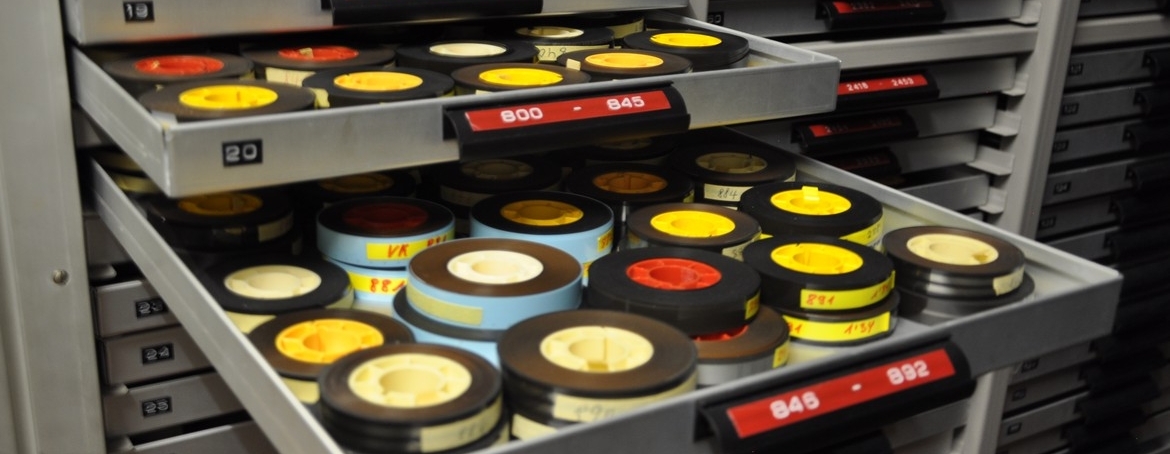Opening up our archives
SRG is progressively opening up its radio and television archives to the general public. In doing so, SRG is acting on its business strategy, which commits it to maintaining the nation’s collective audio and audio-visual heritage. This is all possible thanks to the digitalisation of our archived content, a process that is already well-advanced.
What are the SRG Archives?
The SRG Archives contain over two million hours of radio and television programmes produced by our Enterprise Units, going all the way back to the early 1930s. “The archives are key to shaping our everyday programming. They allow us recall personalities and events from the past as they really were. They also help us to unlock new insights through research and give teachers new, contemporary ways of getting their material across to learners”, explains Theo Mäusli, a Product and Innovation Specialist.
Since 2016, SRG has been given a legal mandate not just to maintain its radio and television archives, but to open them up to the widest possible audience. It is a duty that SRG is well-placed to fulfil, particularly as it has already digitalised almost all of its archives. Our key partners during the digitalisation process were the Swiss National Sound Archives, the Memoriav Association and SRG’s own cultural heritage foundations (Fonsart, Kulturerbe SRF and Patrimonio culturale RSI).
How can I use the archive?
The Enterprise Units within SRG are opening their archives to their own regional audiences. This is being done primarily via their own publication channels, although publications are coordinated across SRG where it makes sense to do so.
The SRG Archives are being published on the basis of five ‘pillars’. Each target audience is provided with different types of access, as described below:
Pillar 1: Archive pages and products from SRG Enterprise Units
The Enterprise Units within the SRG Group offer a wide range of different ways to find archive materials on specific subjects and places, and even on users’ own biographical data. They include archive webpages and regular radio and television programmes on specific topics (either directly from the archive or featuring archive material), as well as installations and events (often organised jointly with our partners) and a range of attractive offerings on social media. Examples of how the material is being used online include:
- RSI: Play RSI: La tua storia, lanostraStoria, the ‘Totem’ installations and the Facebook page
- RTR: Rtr.ch/archiv, Play RTR archive, Facebook page, YouTube channels et nossaIstorgia
- RTS: Rts.ch/archives, notreHistoire, Facebook page and YouTube channels
- SRF: Srf.ch/archiv, Facebook page, YouTube channels and a prototype biography tool (not yet available to the public)
Pillar 2: Access to our radio and television content via players
Around two million audio and video items can already be accessed using the media players operated by SRG’s Enterprise Units. The players allow users to access all content either owned by SRG, or to which SRG is able to acquire the rights under reasonable conditions. The programming we produce is available without restrictions as soon as it has been published, while you can catch up with much of the content we acquire from third parties on demand for up to seven days following the original broadcast. ‘Play’ is already a priceless archive in its own right, and earlier content is being added to it all the time. Content on the players is accessed primarily using the search function.
Pillar 3: Interface-based access for programmers and designers
Since 2017, SRG has been using its Internet platform developer.srgssr.ch to provide a selection of free digital metadata and content for research and development purposes using Application Programming Interfaces (API). For more details, see our Media Release of 15 February 2017. The material available includes a selection of sound recordings, videos, and radio and TV programme data, as well as subtitles, teletext data, and referendum and election results dating all the way back to 1905. Programmers can use this digital material to develop new applications for computers, tablets and smartphones.
Pillar 4: Access for cultural institutions, schools and universities
Since 2018, more than 60 public libraries, documentation centres, universities and schools all over Switzerland have been able to set up local research access to SRG’s digital archives, as well as to the audio-visual databases of the Swiss National Sound Archives and Memoriav (see also our Media Release of 24 October 2018). These terminals are primarily designed to support the teaching of history and historical research. However, the consultation stations in public libraries are also available for public use.
Memoriav and SRG are making radio and television programmes going back to the 1930s available through the online portal memobase.ch. Since 2022 memobase.ch includes around four million files of audio and video material (see also Media Release of 26 October 2021). The portal is aimed at researchers and teaching staff, as well as private individuals.
Pillar 5: Access for Swiss media houses
Journalists working for Swiss media houses have been able to conduct research in the SRG archives since June 2019, as well as to download selected videos via the shared content platform for use on their websites (see also our Media Release of 13 June 2019). SRG retains the rights to all content, but the media companies are allowed to publish the videos within their own Internet presences, many of which are funded by advertising.
SRG is one of the first media houses worldwide to show this level of determination in promoting digitalisation and opening up its archives.
